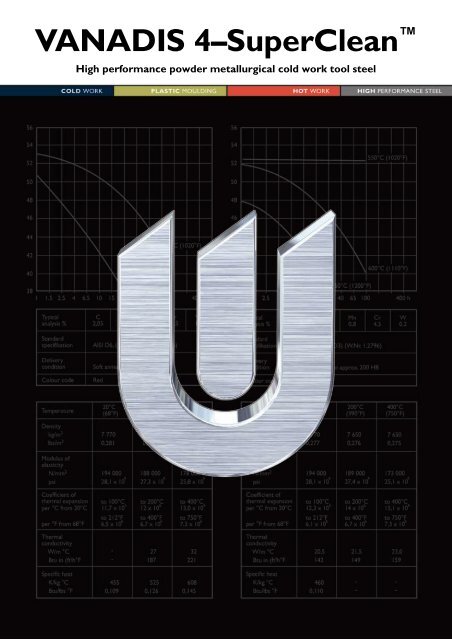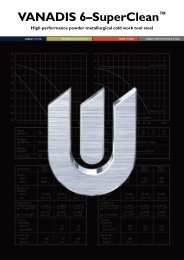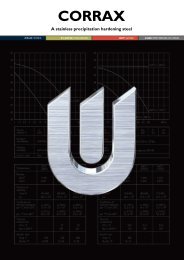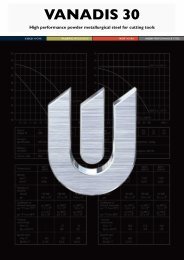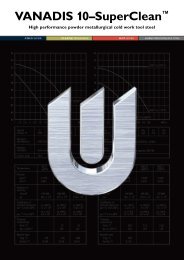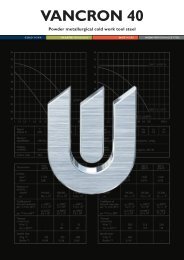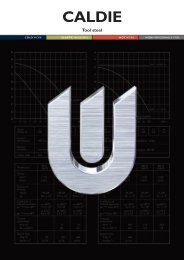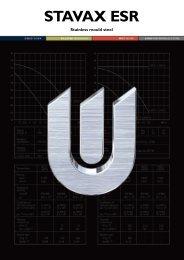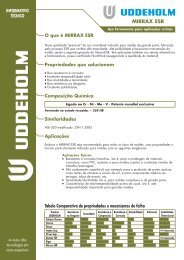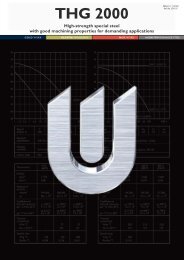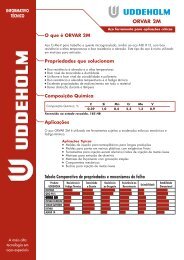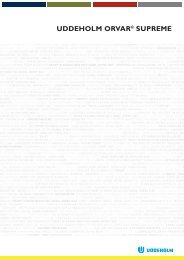VANADIS 4âSuperClean⢠- Uddeholm
VANADIS 4âSuperClean⢠- Uddeholm
VANADIS 4âSuperClean⢠- Uddeholm
Create successful ePaper yourself
Turn your PDF publications into a flip-book with our unique Google optimized e-Paper software.
metall<br />
<strong>VANADIS</strong> 4–SuperClean<br />
<strong>VANADIS</strong> 4<br />
<br />
High performance powder metallurgical cold work tool steel<br />
1
<strong>VANADIS</strong> 4<br />
This information is based on our present state of knowledge and is<br />
intended to provide general notes on our products and their uses. It<br />
should not therefore be construed as a warranty of specific properties<br />
of the products described or a warranty for fitness for a particular<br />
purpose.<br />
2
<strong>VANADIS</strong> 4<br />
Critical tool steel<br />
parameters for<br />
GOOD TOOL PERFORMANCE<br />
• Correct hardness for the application<br />
• High wear resistance<br />
• High ductility.<br />
High wear resistance is often associated with low<br />
ductility and vice-versa. However, for optimal tool<br />
performance both high wear resistance and ductility<br />
are essential in many cases.<br />
<strong>VANADIS</strong> 4 is a powder metallurgical cold work tool<br />
steel offering an extremely good combination of<br />
wear resistance and ductility for high performance<br />
tools.<br />
TOOLMAKING<br />
• Machinability<br />
• Heat treatment<br />
• Dimensional stability on heat treatment<br />
• Surface treatment.<br />
Toolmaking with highly alloyed tool steels means<br />
that machining and heat treatment are often more<br />
of a problem than with the lower alloyed grades.<br />
This can, of course, raise the cost of toolmaking.<br />
Due to the very carefully balanced alloying and the<br />
powder metallurgical manufacturing route, VANA-<br />
DIS 4 has a similar machinability and heat treatment<br />
procedure to the tool steel grade AISI D2.<br />
One very big advantage with <strong>VANADIS</strong> 4 is that the<br />
dimensional stability after hardening and tempering<br />
is much better than for all known high performance<br />
cold work tool steels. This means, for example, that<br />
<strong>VANADIS</strong> 4 is a tool steel which is very suitable for<br />
CVD coating.<br />
Applications<br />
<strong>VANADIS</strong> 4 is especially suitable for applications<br />
where adhesive wear and/or chipping are the<br />
dominating problems, i.e.<br />
• with soft/adherent materials such as austenitic<br />
stainless steel, mild steel, copper, aluminium, etc.<br />
as work material<br />
• with thicker work material.<br />
Examples:<br />
• Blanking and forming<br />
• Fine blanking<br />
• Cold extrusion tooling<br />
• Powder pressing<br />
• Deep drawing<br />
• Knives.<br />
General<br />
<strong>VANADIS</strong> 4 is a chromium-molybdenum-vanadium<br />
alloyed steel which is characterized by:<br />
• High wear resistance<br />
• High compressive strength<br />
• Very good through-hardening properties<br />
• Very good ductility<br />
• Excellent dimensional stability after hardening<br />
and tempering<br />
• Good resistance to tempering back.<br />
Typical C Si Mn Cr Mo V<br />
analysis % 1,5 1,0 0,4 8,0 1,5 4,0<br />
Delivery<br />
condition<br />
Colour<br />
code<br />
Soft annealed to approx. 235 HB<br />
Green/white<br />
3
<strong>VANADIS</strong> 4<br />
Properties<br />
PHYSICAL DATA<br />
Hardened and tempered to 60 HRC.<br />
Temperature 20°C 200°C 400°C<br />
(68°F) (390°F) (750°F)<br />
Density<br />
kg/m 3 7 600 – –<br />
lbs/in 3 0,273 – –<br />
Modulus of<br />
elasticity<br />
N/mm 2 225 000 208 000 190 000<br />
psi 32,6 x 10 6 30,1 x 10 6 27,5 x 10 6<br />
Coefficient<br />
of thermal<br />
expansion per<br />
°C from 20°C – 10,8 x 10 -6 11,9 x 10 -6<br />
°F from 68°F – 6,0 x 10 -6 6,6 x 10 -6<br />
Thermal<br />
conductivity<br />
W/m • °C 15 18 21<br />
Btu in/(ft 2 h °F) 104 125 147<br />
Specific heat<br />
J/kg °C 460 – –<br />
Btu/lb °F 0,11 – –<br />
IMPACT STRENGTH<br />
Approximate room temperature impact strength at<br />
different tempering temperatures.<br />
Specimen size: 7 x 10 x 55 mm (0,27 x 0,40 x 2,2")<br />
unnochted. Hardened at 1020°C (1870°F).<br />
Quenched in air. Tempered twice.<br />
Impact energy Joule<br />
100<br />
80<br />
40<br />
20<br />
60<br />
Hardness HRC<br />
60<br />
55<br />
50<br />
45<br />
40<br />
Heat treatment<br />
SOFT ANNEALING<br />
Protect the steel and heat through to 900°C<br />
(1650°F). Cool in the furnace at 10°C (20°F) per<br />
hour to 750°C (1380°F), then freely in air.<br />
STRESS RELIEVING<br />
After rough machining the tool should be heated<br />
through to 650°C (1200°F), holding time 2 hours.<br />
Cool slowly to 500°C (930°F), then freely in air.<br />
HARDENING<br />
Pre-heating temperature: 600–700°C (1110–<br />
1290°F).<br />
Austenitizing temperature: 980–1100°C (1800–<br />
2010°F). Normally 1020°C (1870°F). For large<br />
sections >70 mm (2,75") use 1060°C (1940°F).<br />
Holding time: 30 min.<br />
N.B. Holding time = time at hardening temperature<br />
after the tool is fully heated through. A holding<br />
time of less than 30 minutes will result in loss of<br />
hardness.<br />
Protect the part against decarburization and<br />
oxidation during hardening.<br />
QUENCHING MEDIA<br />
• Vacuum (high speed gas at sufficient overpressure)<br />
• Martempering bath or fluidized bed at<br />
500–550°C (930–1020°F)<br />
• Martempering bath or fluidized bed at<br />
200–350°C (390–660°F).<br />
Note 1: Temper the tool as soon as its temperature<br />
reaches 50–70°C (120–160°F).<br />
Note 2: In order to obtain the optimum properties<br />
for the tool, the cooling rate should be as fast as is<br />
concomitant with acceptable distortion.<br />
Note 3: Martempering should be followed by<br />
forced air cooling if wall thickness is exceeding<br />
70 mm (2,75").<br />
0<br />
200 300 400 500 °C<br />
390 570 750 930 °F<br />
Tempering temperature (2h + 2h)<br />
35<br />
4<br />
Fine blanking puts very high demands on<br />
wear resistance and ductility, especially<br />
when the work material is thick. Excellent results<br />
have been obtained with this <strong>VANADIS</strong> 4 tool<br />
used for fine blanking 5 mm (0,2") thick material.
<strong>VANADIS</strong> 4<br />
Hardness, grain size and retained austenite as functions of<br />
austenitizing temperature.<br />
Grain size ASTM<br />
Hardness HRC<br />
Retained austenite %<br />
9<br />
68<br />
Grain size<br />
8<br />
66<br />
40<br />
7<br />
6<br />
64<br />
62<br />
As quenched<br />
hardness<br />
30<br />
5<br />
4<br />
3<br />
60<br />
58<br />
56<br />
Retained austenite<br />
20<br />
10<br />
2<br />
54<br />
980 1000 1020 1040 1060 1080 1100 1150°C<br />
1800 1830 1870 1900 1940 1980 2010 2100°F<br />
Austenitizing temperature<br />
TEMPERING<br />
The tempering temperature can be selected according<br />
to the hardness required by reference to the<br />
tempering graph below.<br />
Temper twice with intermediate cooling to room<br />
temperature. The lowest tempering temperature<br />
which should be used is 180°C (360°F). The minimum<br />
holding time at temperature is 2 hours.<br />
In order not to reduce the toughness do not temper<br />
in the range 470–520°C (880–970°F).<br />
Tempering graph<br />
Hardness HRC<br />
66<br />
Austenitizing temperature<br />
64<br />
1020°C (1870°F)<br />
62<br />
60<br />
58<br />
56<br />
980°C 1000°C<br />
(1795°F) (1830°F)<br />
54<br />
52<br />
50<br />
48<br />
46<br />
Retained austenite<br />
1020°C (1870°F)<br />
1234<br />
1234<br />
1234<br />
1234<br />
1234<br />
1234<br />
1234<br />
1234<br />
1234<br />
1234<br />
1234<br />
1234<br />
1234<br />
Retained austenite %<br />
1060°C (1940°F)<br />
200 300 400 500 600 700°C<br />
390 570 750 930 1110 1290°F<br />
Tempering temperature (2h + 2h)<br />
4<br />
3<br />
2<br />
1<br />
Hardness HRC<br />
66<br />
Austenitizing temperature<br />
64<br />
62 1100°C (2010°F)<br />
60<br />
58<br />
56<br />
54<br />
52<br />
50<br />
48<br />
Retained austenite<br />
1100°C (2010°F)<br />
12345<br />
12345<br />
12345<br />
12345<br />
12345<br />
12345<br />
12345<br />
12345<br />
12345<br />
12345<br />
Retained austenite %<br />
1150°C<br />
(2100°F)<br />
15<br />
10<br />
5<br />
46<br />
200 300 400 500 600 700°C<br />
390 570 750 930 1110 1290°F<br />
Tempering temperature (2h + 2h)<br />
5
<strong>VANADIS</strong> 4<br />
TTT-graph<br />
Austenitizing temperature 1020°C (1870°F). Holding time 30 minutes.<br />
Temperature<br />
°F °C<br />
2000 1100<br />
1800 1000<br />
900<br />
1600<br />
800<br />
1400<br />
700<br />
1200<br />
600<br />
1000<br />
500<br />
800<br />
400<br />
600 300<br />
400 200<br />
200<br />
100<br />
M s<br />
Martensite<br />
Bainite<br />
Pearlite<br />
1 10 100 1 000 10 000 100 000 Seconds<br />
1 10 100 1 000 Minutes<br />
1 10 100 Hours<br />
Air cooling of<br />
0,2 1,5 10 90 600 bars, Ø mm<br />
0,0079 0,059 0,394 3,54 23,6 inch<br />
A C1f<br />
930°C (1705°F)<br />
A C1s<br />
865°C (1590°F)<br />
Temp. Time Hardness<br />
°C. hours HV10<br />
825 4,6 530<br />
800 18,2 222<br />
750 1,0 270<br />
700 1,8 213<br />
650 47,1 342<br />
600 70,3 370<br />
450 19,3 803<br />
400 25,9 772<br />
350 18,0 792<br />
300 2,6 634<br />
250 5,3 606<br />
CCT-graph<br />
Austenitizing temperature 1020°C (1870°F). Holding time 30 minutes.<br />
Temperature<br />
°F °C<br />
2000 1100<br />
1800 1000<br />
900<br />
1600<br />
800<br />
1400<br />
700<br />
1200<br />
600<br />
1000<br />
500<br />
800<br />
400<br />
600 300<br />
400 200<br />
200<br />
100<br />
M s<br />
Martensite<br />
Carbides<br />
Pearlite<br />
M f<br />
Bainite<br />
1 2 3 4 5 6 7 8 9<br />
1 10 100 1 000 10 000 100 000 Seconds<br />
A C1f<br />
A C1s<br />
Cooling<br />
curve Hardness T 800–500<br />
No. HV 10 (sec)<br />
1 835 1<br />
2 835 14<br />
3 824 42<br />
4 782 139<br />
5 782 415<br />
6 724 700<br />
7 620 2077<br />
8 483 3500<br />
9 274 7000<br />
1 10 100 1 000 Minutes<br />
1 10 100 Hours<br />
0,2 1,5 10 90 600<br />
0,0079 0,059 0,394 3,54 23,6<br />
Air cooling of<br />
bars, Ø mm<br />
inch<br />
6
<strong>VANADIS</strong> 4<br />
DIMENSIONAL CHANGES DURING HARDENING<br />
Sample plate 100 x 100 x 25 mm (4" x 4" x 1").<br />
Dimensional change, %<br />
▲<br />
0,08<br />
0,04<br />
0<br />
-0,04<br />
Length Width Thickness<br />
Sample cube 80 x 80 x 80 mm<br />
(3 1/8" x 3 1/8" x 1/8").<br />
Dimensional change, %<br />
▲<br />
0,08<br />
0,04<br />
SUB-ZERO TREATMENT<br />
Pieces requiring maximum dimensional stability can<br />
be sub-zero treated as follows:<br />
Immediately after quenching the piece should be<br />
sub-zero treated to between –70 and –80°C (–95 to<br />
–110°F), soaking time 3–4 hours, followed by<br />
tempering. Sub-zero treatment will give a hardness<br />
increase of ~1 HRC. Avoid intricate shapes as there<br />
will be risk of cracking.<br />
NITRIDING<br />
Nitriding gives a hard surface layer that is resistant<br />
to wear and erosion.<br />
<strong>VANADIS</strong> 4 is normally high temperature tempered<br />
at around 525°C (980°F). This means that the<br />
nitriding temperature used should not exceed 500–<br />
525°C (930–980°F). Ion nitriding at a temperature<br />
below the tempering temperature used is preferred.<br />
The surface hardness after nitriding is approximately<br />
1250 HV 0,2 kg . The thickness of the layer should be<br />
chosen to suit the application in question.<br />
0<br />
-0,04<br />
Length Width Thickness<br />
980°C (1800°F), 30 min.<br />
1020°C (1870°F), 30 min.<br />
1050°C (1920°F), 30 min.<br />
DIMENSIONAL CHANGES DURING TEMPERING<br />
Dimensional change, %<br />
+0,08<br />
+0,04<br />
Blanking tool made from <strong>VANADIS</strong> 4 for blanking of<br />
10 mm (0,4") thick plate.<br />
0<br />
–0,04<br />
–0,08<br />
100 200 300 400 500 600 °C<br />
210 390 570 750 930 1110 °F<br />
Tempering temperature<br />
Note: The dimensional changes on hardening and<br />
tempering should be added together.<br />
7
<strong>VANADIS</strong> 4<br />
Machining<br />
recommendations<br />
Feed (f)<br />
Face grinding A 46 HV B107 R75 B3 1)<br />
mm/rev 0,05–0,25 2) 0,10–0,25 2) 0,15–0,25 2) straight wheel 3SG 46 GVS 2)<br />
MILLING<br />
Face and square shoulder milling<br />
Milling with carbide Milling with<br />
The cutting data below are to be considered as<br />
Cutting data Rough Fine HSS<br />
guiding values which must be adapted to existing<br />
parameters milling milling Fine milling<br />
local conditions.<br />
Cutting speed (v c )<br />
m/min. 50–90 90–110 10<br />
TURNING<br />
f.p.m. 160–295 295–360 33<br />
Feed (f z )<br />
Turning with carbide Turning<br />
mm/tooth 0,2–0,4 0,1–0,2 0,1<br />
Cutting data Rough Fine with HSS<br />
in/tooth 0,008–0,016 0,004–0,008 0,004<br />
parameters turning turning Fine turning<br />
Depth of cut (a p )<br />
Cutting speed (v c )<br />
mm 2–5 – 2 – 2<br />
m/min. 70–100 100–150 15<br />
inch 0,08–0,20 – 0,08 – 0,08<br />
f.p.m. 230–320 320–490 50<br />
Carbide<br />
Feed (f)<br />
designation ISO K15* K15*–<br />
mm/rev 0,3–0,6 – 0,3 –0,3<br />
i.p.r. 0,01–0,024 – 0,01 – 0,01<br />
*Use a wear resistant Al 2 O 3 -coated carbide grade, e.g. Sandvik<br />
Depth of cut (a p )<br />
Coromant GC 3015 or SECO T10M<br />
mm 2–6 – 2 – 2<br />
inch 0,08–0,24 – 0,08 – 0,08<br />
Machining group<br />
End milling<br />
ISO K15* K15* –<br />
Type of milling<br />
* Use a wear resistant Al 2 0 3 -coated carbide grade, e.g.<br />
Cutting data Solid Carbide index- High speed<br />
Sandvik Coromant GC 3015 or SECO TP05.<br />
parameters carbide able insert steel<br />
Cutting<br />
speed (v c )<br />
m/min. 25 60–100 10 1)<br />
DRILLING<br />
f.p.m. 80 195–330 33 1)<br />
High speed steel twist drill<br />
Feed (f z )<br />
mm/tooth 0,03–0,2 2) 0,08–0,2 2) 0,05–0,35 2)<br />
Drill diameter Cutting speed (v c ) Feed (f)<br />
in/tooth 0,001–0,008 2) 0,003–0,008 2) 0,002–0,014 2)<br />
mm inch m/min f.p.m. mm/rev i.p.r.<br />
Carbide<br />
–5 –3/16 10* 33* 0,08–0,20 0,003–0,008 designation<br />
5–10 3/16–3/8 10* 33* 0,20–0,30 0,008–0,012<br />
ISO K20 K15 3) –<br />
10–15 3/8 –5/8 10* 33* 0,30–0,35 0,012–0,014<br />
15–20 5/8 –3/4 10* 33* 0,35–0,40 0,014–0,016<br />
1)<br />
For coated HSS end mill v c ≈14m/min. (45 f.p.m.)<br />
* For coated HSS drills v c ~14 m/min. (45 f.p.m.).<br />
2)<br />
depending on radial depth of cut and cutter diameter<br />
3)<br />
Use a wear resistant Al 2 O 3 -coated carbide grade<br />
Carbide drill<br />
Type of drill<br />
GRINDING<br />
A general grinding wheel recommendation is given<br />
Cutting data<br />
parameters<br />
Cutting<br />
speed (v c )<br />
Indexable<br />
insert<br />
Solid<br />
carbide<br />
Brazed<br />
carbide 1)<br />
below. More information can be found in the<br />
<strong>Uddeholm</strong> publication “Grinding of Tool Steel”.<br />
Wheel recommendation<br />
m/min. 100–150 45 30<br />
Soft annealed Hardened<br />
f.p.m. 330–490 145 100<br />
Type of grinding condition condition<br />
1)<br />
Drills with internal cooling channels and a brazed<br />
C46 GV<br />
carbide tip.<br />
Face grinding A 24 GV 3SG 46 FVSPF 2)<br />
2)<br />
Depending on drill diameter.<br />
segments<br />
A46 FV<br />
Cylindrical grinding A 60 JV B126 R75 B3 1)<br />
5SG 70 IVS 2)<br />
C60 IV<br />
Internal grinding A 46 JV B107 R75 B3 1)<br />
3SG 60 JVS 2)<br />
C60 HV<br />
Profile grinding A 100 LV B107 R100V 1)<br />
5SG 80 JVS 2)<br />
C120 HV<br />
1)<br />
If possible use CBN wheels for this application.<br />
2)<br />
Grinding wheel from Norton Co.<br />
8
<strong>VANADIS</strong> 4<br />
Electrical-discharge<br />
machining —EDM<br />
If EDM is performed in the hardened and tempered<br />
condition, finish with “fine-sparking”, i.e. low<br />
current, high frequency.<br />
For optimal performance the EDM’d surface should<br />
then be ground/polished and the tool retempered<br />
at approx. 25°C lower than the original tempering<br />
temperature.<br />
When EDM’ing larger sizes or complicated shapes<br />
<strong>VANADIS</strong> 4 should be tempered at high temperatures,<br />
above 500°C (930°F).<br />
Relative comparison of<br />
<strong>Uddeholm</strong> cold work tool steel<br />
MATERIAL PROPERTIES AND RESISTANCE TO FAILURE MECHANISMS<br />
Hardness/ Fatigue cracking resistance<br />
Resistance Resistance to Ductility/ Toughness/<br />
<strong>Uddeholm</strong> to plastic Machin- Grind- Dimension Abrasive Adhesive resistance to gross<br />
grade deformation ability ability stability wear wear chipping cracking<br />
CALMAX<br />
SLEIPNER<br />
SVERKER 21<br />
<strong>VANADIS</strong> 4<br />
<strong>VANADIS</strong> 6<br />
<strong>VANADIS</strong> 10<br />
<strong>VANADIS</strong> 23<br />
<strong>VANADIS</strong> 30<br />
<strong>VANADIS</strong> 60<br />
AISI M:2<br />
9


